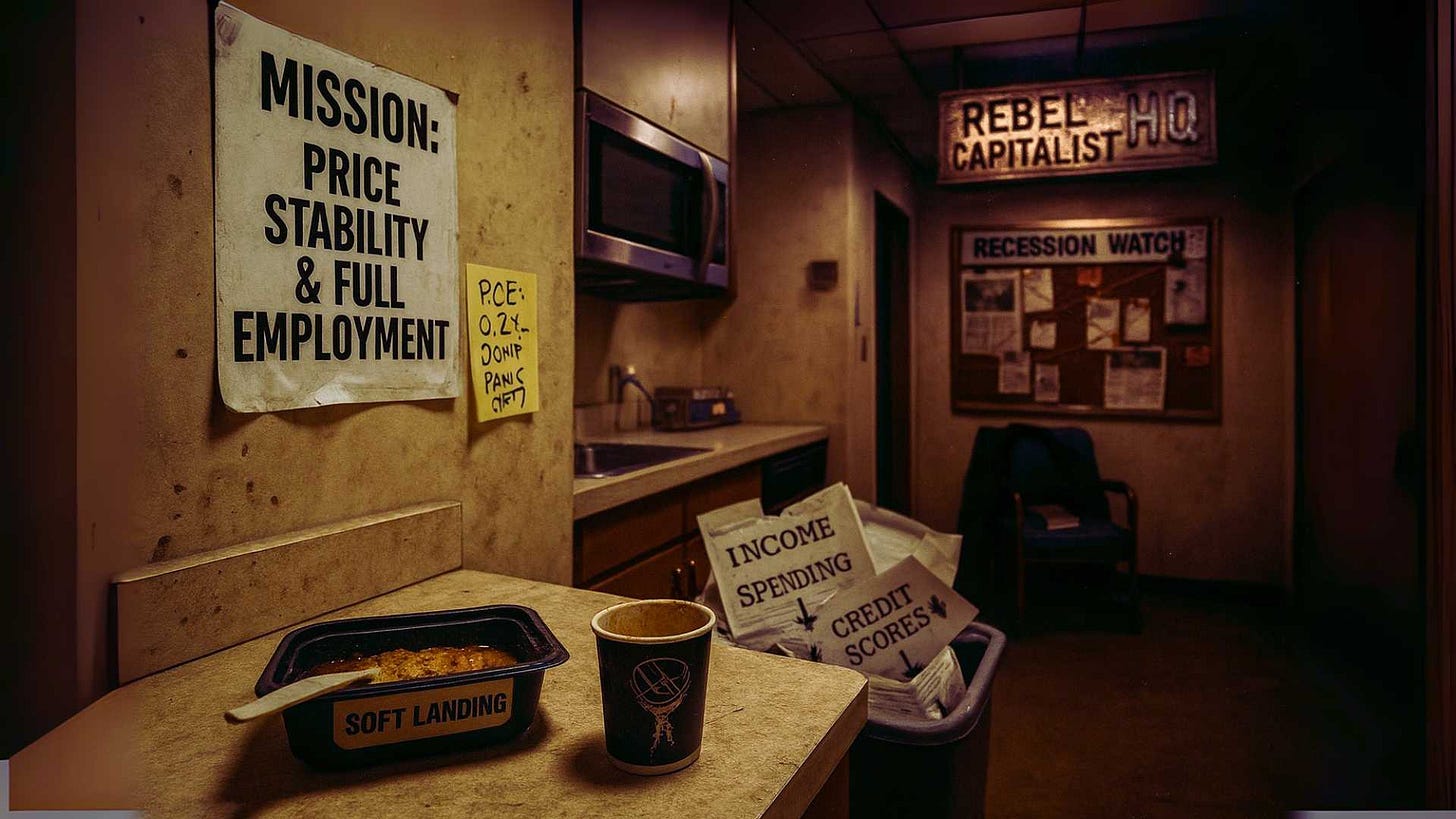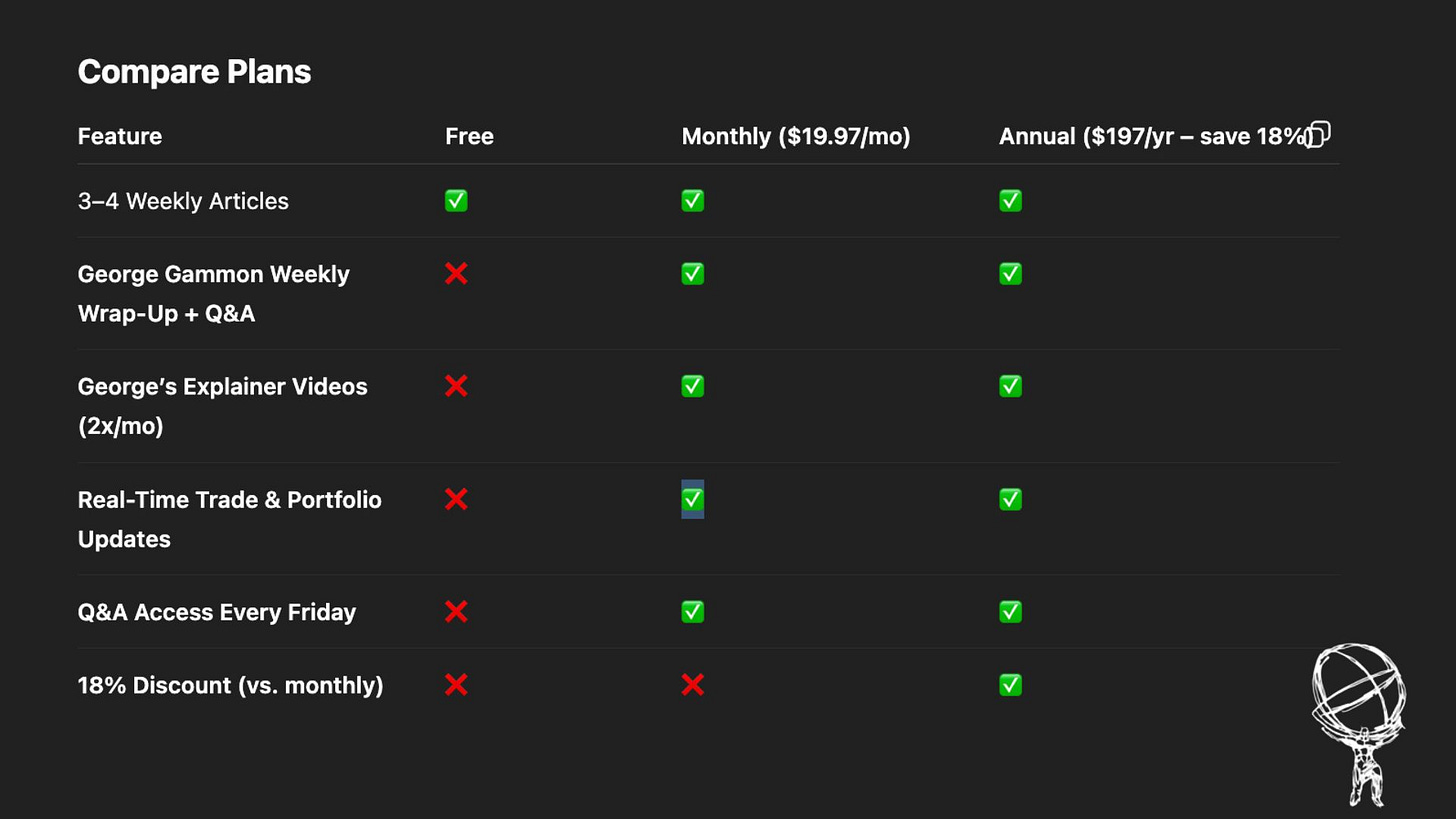Inflation's Surprise Spike...
...Won’t Save the Fed From the Bigger Problem
Written by Rebel Capitalist AI - Supervision and Topic Selection by George Gammon
June 27, 2025
The June 27th release of economic data brought a jolt to the market…core PCE came in hotter than expected.
At first glance, this might seem like a red flag suggesting inflation is reaccelerating.
But if you dig deeper, you’ll see this is just one tree in a much bigger forest…and the rest of the forest is showing signs of economic stress.
We’ll break down exactly what the new data shows, why the Fed's focus on inflation may be misplaced, and why the labor market…and not inflation…is the real risk.
Core PCE Higher Than Expected…But Don’t Overreact
Today’s data showed that core Personal Consumption Expenditures (PCE)…the Fed’s preferred inflation gauge…rose 0.2% month over month, compared to expectations of 0.1%.
Year-over-year, the reading ticked up to 2.7%, versus last month’s 2.6%.
At first glance, this uptick in inflation seems to validate the Fed’s hawkish stance. Jerome Powell has been steadfast in his warnings about premature rate cuts potentially reigniting inflation.
In fact, this data pushed the market-implied probability of a Fed rate cut in July up from around 73% to 80%, before rebounding slightly after deeper data analysis.
But while inflation surprised to the upside, the core story today isn't inflation…it’s the weakening consumer.
Personal Income and Spending: The Bigger Miss
Even more important than the core PCE reading was the significant downside surprise in personal income and spending:
Personal income was expected to rise by 0.3%. Instead, it fell -0.4%.
Personal spending came in at -0.1%, versus expectations of a small increase.
This is a huge miss. And the mainstream excuse…blaming cold weather…isn’t convincing. If cold weather was expected, analysts should have already priced it in.
Either way, it doesn't justify such a large divergence from expectations.
What’s clear is that Americans are making less and spending less, and that’s a bigger problem than a 0.1% upside surprise in core PCE.
Why This Doesn’t Signal Inflation is Ramping Up
Core PCE ticked up slightly, but the basket is still dominated by domestic services, which aren’t directly impacted by tariffs or global supply chain disruptions.
The 40% of the basket composed of goods might be affected by recent trade policy changes, but the remaining 60%…services like rent, insurance, and travel…are dependent on domestic consumption and wage growth.
If income and spending are dropping, it’s hard to see how services inflation will sustain itself, much less reaccelerate.
Think about it like this: If people spend more at Walmart because of higher tariffs on imported goods, they’re probably cutting back somewhere else…say, airline tickets or restaurants.
You’re not getting broad inflation, just reallocation.
The Fed’s Balancing Act: Inflation vs. Labor Market
Powell remains focused on inflation, likely fearing a repeat of Arthur Burns’ mistakes in the 1970s. But many other Fed officials…like Waller and Bowman…are now more worried about the labor market than inflation.
That divide is increasingly hard to ignore. The Fed’s dual mandate is price stability and full employment. With inflation mostly under control and employment starting to wobble, the emphasis should shift.
And when you add in the data from personal income and spending, the picture becomes clearer: the economy is softening, and the risk of recession or stagflation is increasing.
Student Loans and the Hidden Drag on Demand
Another underreported factor that will suppress demand: student loan repayments.
The New York Fed’s own blog recently highlighted that delinquencies on student loans are surging now that forbearance has ended. These delinquencies will hit credit scores hard, potentially dropping some borrowers’ scores by more than 150 points.
Stephanie Pomboy recently noted that one in three student loan borrowers are at risk of becoming delinquent.
If even a fraction of these borrowers can no longer access credit for homes, cars, or other big-ticket items, the impact on aggregate demand will be significant.
The Fed loves to talk about “financial conditions.” Well, they’re about to get tighter…not because of rate hikes, but because of a credit contraction driven by delinquency.
GDP and Inventory Data Paint a Grim Picture
Yesterday’s final Q1 GDP revision showed a negative 0.5% reading, confirming a contraction.
Meanwhile, inventory data showed that businesses are cutting back, not stocking up…another sign of deteriorating demand.
The Atlanta Fed’s GDPNow model had to revise Q2 GDP down from 3.4% to 2.9%, mainly because inventories were declining more than expected.
The market was hoping trade deficits would normalize and boost GDP.
Instead, inventories shrank and net exports underdelivered.
If this trend continues, we could easily see two consecutive quarters of negative real GDP…the textbook definition of a recession.
The Fed’s Framework Isn’t Holding Up
Let’s be clear: if the Fed followed its own framework and focused on the totality of economic data, they’d already be cutting rates.
Inflation is moderating, with core PCE only modestly above target.
Income and spending are falling…bad signs for aggregate demand.
GDP is shrinking.
Credit conditions are tightening via delinquency and lower credit scores.
The evidence is piling up that the risk to growth and employment is now greater than the risk of a renewed inflation spiral.
Final Thoughts: What Smart Investors Should Watch
Today’s data changed the narrative…again. The market reaction tells you everything you need to know:
Yields fell across the curve.
Rate cut odds increased despite a hot inflation print.
The dollar weakened, pricing in narrowing rate differentials.
Investors who only look at one data point…like a 0.2% PCE print…will miss the bigger picture.
The real risks now are:
A weakened labor market
Falling consumer demand
A tightening credit environment
Those betting on inflation’s return may be blindsided by a recession.
Those who stay focused on the full economic picture…including data like today’s personal income, spending, and student loan delinquencies…will be in a better position to profit.
👉 Front run big government and out-of-control central banks..for less than a daily cup of coffee.
Rebel Capitalist AI
Supervision and Topic Selection by George Gammon
June 27, 2025






Why should anybody be surprised. Their numbers have been pure bullshit for decades. Coffee I order from the jungle website jumped 40% from the previous year.